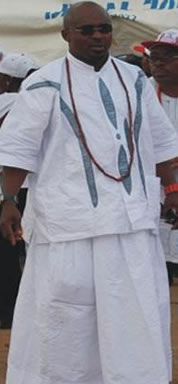 |
In recent times, there has been a growing tendency among young Bini men to neglect the traditional dress Patten even when marriage under native law and custom is being contracted. The young women on their part have kept meticulously to the fashion of wearing the appropriate traditional (bridal) dress patterns .Some of the men folk seem feel that wearing any “national” dress of Nigeria like “buba and “shokoto” or full “agbada” with traditional beads will suffice. The old Benin dressing pattern is throwing the wrapper. Flowing over the left shoulders with or without the tunic or tying the wrapper across the waist and leaving the chest bare .The wrapper was made of hand woven. 2 to 3 -piece of cloth, sewn together over the round underwear “Ebuluku”, hand-woven apparel sewn in a round shape, belted around the waist line. That was the commonest mode of dressing for the men folks, who were not yet titled chiefs. Alternatively, the wrapper could be wound around the lower abdomen and the excess piece thrown over the left shoulders and held in place with a horse tail.
The Chiefs and Enigie (Dukes) of the land have carefully preserved their patterns and modified them where appropriate. The Chiefs’ dress consisted of the loin cloth (wrapper) tied up the hip in a particular pattern known as EYOEN which could be of various shapes like UHUMWUN OGHO (Sheep’s head) with appropriate beads to match. The chest was left bare, but a tunic (sleeve-less shirt) could be worn during the Harmattan (cold) season. The tunic was part of the habiliments of war and was also worn to the farm by elderly People.
The Ebuluku (round knickers) was worn as under-dress before the loincloth or wrapper was beautifully attired in the preferred shape, for Princes, titled chiefs and palace functionaries.
THE CASSOCK FOR TITLED CHIEFS AND PRINCES
An alternative dress for the Princes, Chiefs, Enigie -(Dukes) and}is Majesty the Oba was fashioned in 1934 during the early period of the reign of Oba Akenzua II in form of a cassock. The origin has been documented in Dr. Ekhaguosa Aisiens Book “IWU”. |